Casi y el Viejo: en busca de un (no) lugar. La relación espacio-identidad en Cara de pan de Sara Mesa
Casi and the Old man in search of a (non) space. The relationship between space and identity in Cara de pan by Sara Mesa
Autor
García, Noelia S.
Editor
UCOPressFecha
2019Materia
EspacioNo lugar
Identidad
Víctima
Sociedad
Space
Non-place
Identity
Victim
Society
METS:
Mostrar el registro METSPREMIS:
Mostrar el registro PREMISMetadatos
Mostrar el registro completo del ítemResumen
El encuentro fortuito de una adolescente (Casi) y un hombre maduro (el Viejo) en un parque es el punto de partida de Cara de pan, la última novela de Sara Mesa. Forjan una relación que los códigos morales y sociales nunca aceptarían. Únicamente puede entenderse en un espacio que les proporciona anonimato, en un no lugar, en el que crearán un microcosmos que les permita relacionarse con libertad. Así, los espacios por los que transitan los protagonistas no son simples lugares de paso, sino que funcionan como elementos constituyentes de identidades. De esta forma, Casi y el Viejo se presentan como dos personajes fuera de lugar dentro de la sociedad y conformarán dos identidades marginales dentro de un espacio propio creado sobre un no lugar. A chance meeting in a park between Casi, a teenage girl, and the Old Man, a middle-aged man, is the starting point of Cara de pan, the latest novel by Sara Mesa. These characters develop a relationship that moral and social codes would never accept. This relationship can only be understood in a space that grants them anonymity, a non-place where they create a microcosm where they can freely interact. Therefore, the spaces where the characters move are not just places to pass through: they work as essential elements which create identities. This way, Casi and the Old Man are presented as two characters out of place in society who shape two marginal identities inside their own space, created over a non-place.

